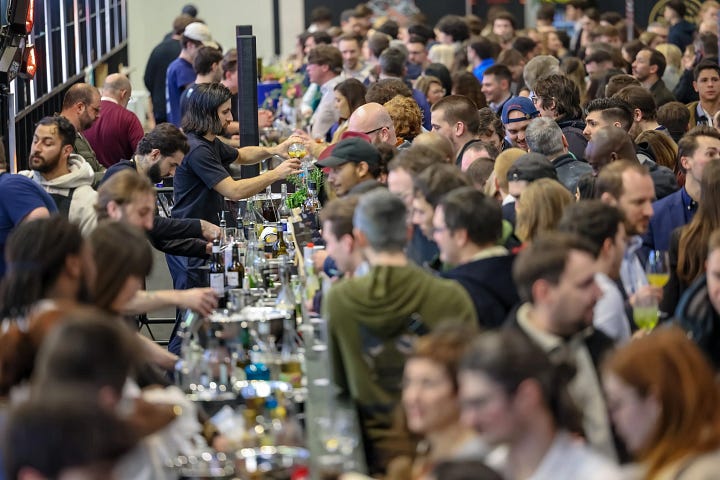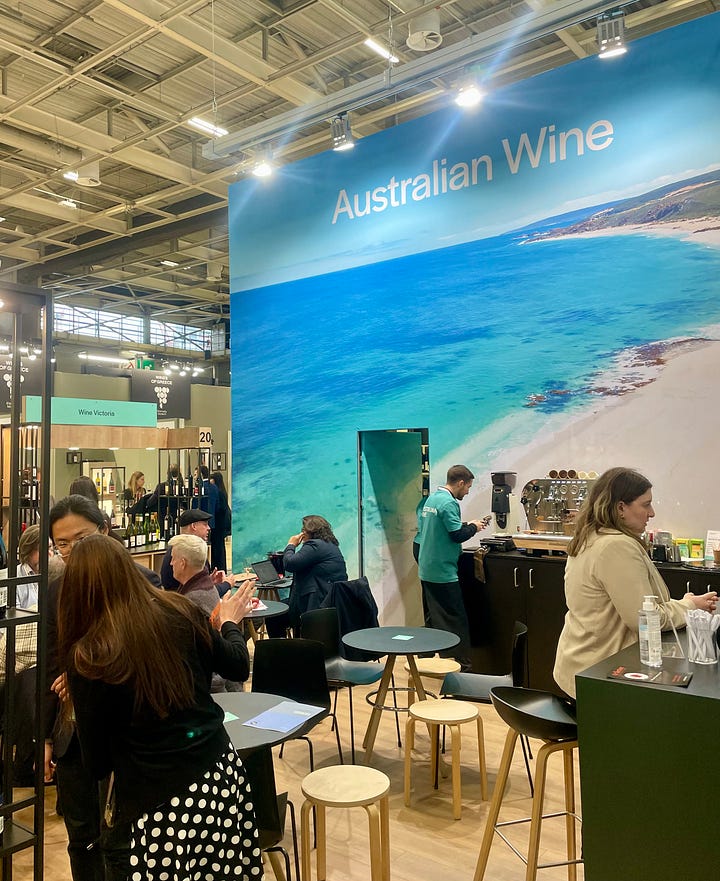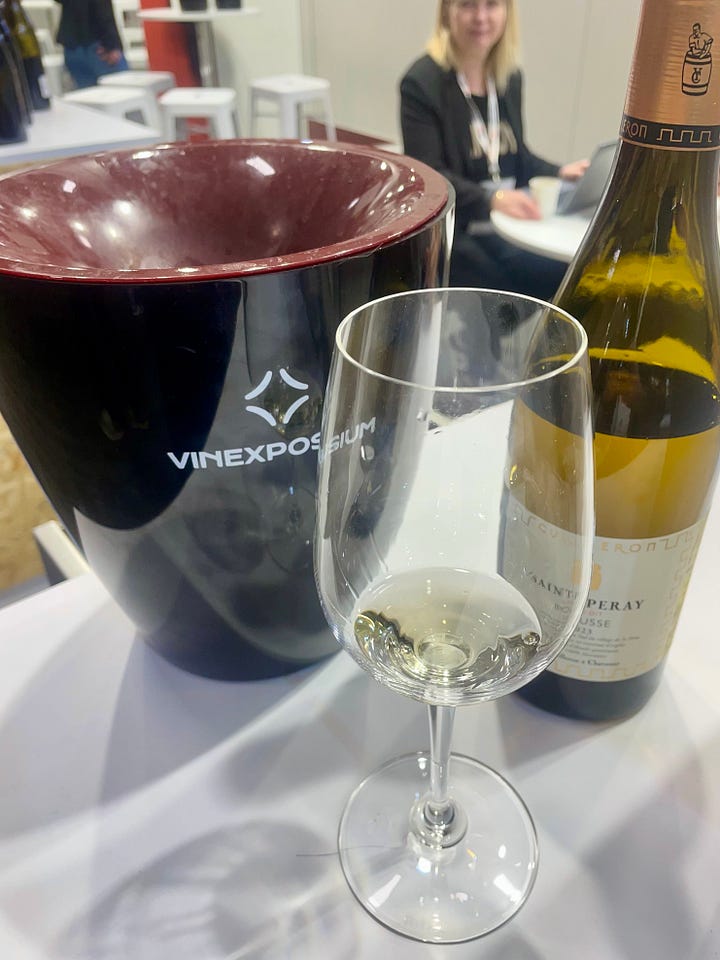All the fun of the (wine) fair
While it was all a bit bonkers, there was a strongly international flavour to last week's giant Wine Paris event. Plus: what I've been drinking on the road in Portugal since then




At the Tbilvino stand, a stout middle-aged man addressed the Georgian winery’s rep in Italian; with no common tongue, they resorted to sign language. Next door at Wines of Lebanon, some Estonians were managing fine in English with their trilingual Arab hosts. But across the hall at a Mallorcan producer, the English speaker I’d been talking to had to switch with her Spanish-only colleague, with whom I continued my tasting in that language, so that she could speak to a Finnish buyer in the new lingua franca. Welcome to the Babel of the Paris wine fair.
It was my first trip to this, one of the world’s two biggest wine industry events - only Düsseldorf’s ProWein is larger. I’ve been to the London and Barcelona wine fairs before but Wine Paris was on a different scale entirely. And I had travelled to Paris for work only once before, a day trip as an Evening Standard journalist, talking to the creators of the Vélib’ cycle-hire scheme. So for me it also marked a new experience in the city that is almost the Ur tourist destination.
This will always be the capital where I arrived age 18 at the start of an Interrail tour, fresh off the boat train with my high-school girlfriend: grinning in the early morning sunshine at our apparent emergence as adults, newly hatched on the grass by the Place du Carrousel. For me, it is the city where I came with another girlfriend years later, laughing as we swigged red wine from the bottle in the Buttes Chaumont, and in the same park with her many more years on where our three children whooped amid freshly fallen February snow. A city to measure out your years; not a place for laptops and business cards.
There’s admittedly not much space for such contemplation amid the bedlam of a giant trade fair. In many ways it has virtually nothing to do with most peoples’ experience of wine. It is an almost entirely professional event, with the 52,000-odd visitors made up mostly of wine producers, buyers, importers and journalists, talking to more than 4,000 exhibitors. Along the endless walkways of five vast exhibition halls at the Porte de Versailles, people discussed ex-cellar prices and the Chinese market. The Spanish entertained over plates of jamón. But very few people were actually drinking wine
It’s hard work (trust me: tasting around 200 wines and talking to scores of people in several languages over three days is tiring.) But it’s friendly enough. As a wine professional, you run into people you know: “Andy Neather, as I live and breathe!” exclaimed one British PR. I caught up with Château Ksara’s Elie Maamari and other Lebanese friends. I swapped asthma symptoms with a sixty-something Dão producer. And at dinner on the first night at the impossibly quaint Parisian bistro, Auberge Bressane, I found myself on a table between a Dutch importer and two Ribera del Duero winemakers: the latter shared a fine bottle of theirs and conversation flowed in English and Spanish.
Yet all these interactions – and at this year’s Paris fair especially – underlined to me more than ever the fundamentally global nature of the wine industry and its long supply chains and far-flung markets. This is something I’ve been thinking about a lot as I co-write and research my forthcoming book on wine and sustainability with Jane Masters MW.
Days before Paris, we’d travelled together to one of Britain’s biggest bulk bottling plants, Greencroft, near Durham. In a vast hangar, Australian wine filled glass bottles (British, French or German-made) before they zipped along packing lines. On the line in the next building, French Merlot filled aluminium drinks cans made in the Netherlands by an Irish company. And later last week I was on the road in Portugal watching the world’s biggest cork producer, Amorim, make corks destined for drinks firms across more than 100 countries.
This is the international reality that Vinexpo (as Wine Paris used to be known) embraced this year more aggressively than ever before. It was also a naked play to take ProWein’s crown as the biggest wine event. The post-fair consensus seems to be that they might have pulled it off. For the hordes of buyers and journalists, it’s not just bad feeling over years of price gouging by German hotels. I mean, which would you rather go to for a work trip: Paris or the post-industrial Ruhr?
Thus not only was international Hall 4 the biggest, plus another hall for Italy (France had three halls, and there was another dedicated to spirits and no/low alcohol.) Amazingly for France, most of the organised seminars and masterclasses were conducted in English – including one of the highest-profile roundtable sessions, chaired by Vinexpo CEO Rodolphe Lameyse and with international speakers including the UK Wine and Spirit Trade Association’s CEO, Miles Beale.
Wine Australia were at Paris in force, holding standing-room-only seminars on cool-climate Aussie Chardonnay and the like; they have announced that they’re not going to bother with ProWein now. The US presence was sizeable too, with extensive pavilions dedicated to California, Oregon and Washington. And my only foray into the hall dedicated to Bordeaux was to meet up for a chat about sustainability with Chilean producer Santa Rita, stationed in their Bordeaux broker’s pavilion with other high-end international brands.
Similarly this was the first Paris fair for English industry body WineGB. English producers at the busy Wine GB pavilion told me they’d had discussions with new distributors from the Netherlands, Spain, Portugal, France, Switzerland, China and Thailand. I had a fascinating chat with Ruth and Charles Simpson, of Kent’s Simpsons’ Wine Estate, about their surprisingly large sales in Norway. “There’s been more interest than we expected,” Hundred Hills’ Cat Hamlet told me. “It’s been really interesting,” said Wendy Outwaithe, co-owner of Sussex’s Ambriel. “There’s been a huge amount of curiosity and a really warm welcome.”
Their upbeat mood said something for the English industry’s ambition – as well as the ambitions of their French hosts. But in fact, Paris’s embrace of international trade isn’t so surprising. While I often find French chauvinism about their food and wine irritating – for instance when forcing down a grim €9.50 chicken sandwich from the Hall 4 cafeteria – their food and drink industries are very sharp at the business of selling those goods across multinational supply chains. There’s a reason why the likes of Pernod Ricard, LVMH, Danone and the rest are as internationally successful as they are, and it isn’t because of attachment to tradition: a ruthless focus on markets rather than the town-square marché.
It's true that the wine industry’s global woes were a persistent undercurrent. Wine sales are down in all the major markets, especially the US. On the second day of the fair, the French wine and spirits export body released figures showing that 2024 exports had fallen four per cent in value. Weeks earlier, big south-western French Armagnac and wine producer Domaine Tariquet caused shockwaves when it went into administration, citing a 30 per cent drop in sales. Such pressures are partly why Wine Paris and many of its denizens were hustling so hard.
But for someone in the wine world like me, it felt the place to be. And in the end that internationalism is appropriate to Paris, the city the whole world visits. Not that the rest of Paris really noticed our wine chatter, I’m sure: a couple of hundred metres from the Porte de Versailles métro, the crowds of the wine fair became invisible, scarcely ruffling the surface of life in the City of Light. And I certainly didn’t try asking for an Australian Chardonnay with dinner.
Some of my favourites from Wine Paris
Voskeni “130 Reserve” Areni 2019 – Voskeni’s co-founder, Alina Mkrtchyan, told me the story of how her grandfather moved from Boston back to Armenia and bought a vineyard - before the property was confiscated by the Bolsheviks. Her family finally moved back to Armenia from Russia in 2008 and restored the property. This red wine is made from130-year-old vines grown at 1600 metres of altitude. It’s intriguing, complex, long – and pretty serious, though Mkrtchyan doesn’t yet have a UK distributor.
Dalt Turó “Sauló” 2020 - this red is the Mallorcan producer’s top cuvée, 1800-odd bottles produced only in best years. It’s mostly local grapes Callet and Manto Negro plus a little Syrah and Cabernet Sauvignon, matured in old barrels: savoury, balanced, long – wonderfully different (N/A UK.)
Ixsir Grand Reserve 2017 - this Syrah/Cabernet Sauvignon blend from one of Lebanon’s newer producers has had 12 months in barriques but the oak is better integrated at this point than in some more traditional Lebanese reds: rich, plush, balanced and delicious (Vinum, £29 - other vintages available elsewhere.)
Yves Cuilleron La Petite Côte 2023, Condrieu - I’ve long admired Cuilleron’s northern Rhône wines but this was the first time I’d tasted his whole - substantial - range. So many ravishing wines but this Condrieu particularly blew me away: classic, beautiful apricot-scented fruit, so elegant. Just gorgeous (Vinatis, Carringtons Wines and in bond, from £35.85.)
Château Maucoil “L’Esprit de Maucoil” 2013, Châteauneuf-du-Pape - this older vintage of this producer’s top red Châteauneuf was just sublime: amazing spicy aromas, lovely sweet fruit, fine and very long (N/A UK though their straight Châteauneufs and Côtes du Rhônes are available here, imported by Boutinot.)
What I’ve been drinking… in Porto
A night home from Paris and I was off again, this time to Portugal to investigate cork production for my sustainability book. I did, however, take the weekend after that off in Porto - of which more in a little while. These were some of my favourite wines that I drank there:
Xisto Ilimitado 2023, Douro - this white from Luis Seabra is a blend of local Rabigato, Gouveio and Arinto grapes (no, I hadn’t heard of the first two, either); its bright, juicy fruit is beautifully balanced with fresh minerality. Lovely. I drank this at London chef Nuno Mendes’s dazzling Porto restaurant, Cozinha das Flores (Vinatis, All About Wine, Vinum, from £18.92.)
Ana Cardoso Pinto “Purista” 2023, Lisboa - Ana Cardoso Pinto worked as an architect before becoming a winemaker and her white wine is indeed beautifully constructed. From the local Fernão Pires grape, this is aromatic and suprisingly complex: fresh, almost slightly saline, quite elegant. I had this at brilliant French-influenced restaurant Apego (N/A UK.)
Alquimista Tinto 2023, Douro - with just 2,300 bottles made by a natural-leaning winemaker, this blend of Tinto Cão and Touriga Franca is proof that Douro reds don’t have to be either oaked or overbearing. Sweet fruit with good acidity and definition, nicely balanced. I drank this in the A Cave do Bon Vivant wine bar, run by engaging if slightly mad Frenchman Stan Wallut (N/A UK.)





Fascinating as usual. I had no idea about Greencroft. I was labouring under the obviously outdated impression that wine had to be bottled before it was exported to help ensure it actually is what it says on the label.